

Newsletter CISB n.1 | December 2011

MEETING
The first of many meetings
First Annual CISB Meeting defines paths for cooperation via open innovation between Brazil and Sweden and promotes a space for integration
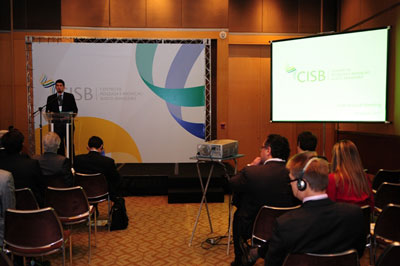 With the purpose of starting a fixed calendar of debates about the cooperation between Brazil and Sweden and strengthen bilateral innovation networks, the Swedish-Brazilian Research and Innovation Center (CISB) held in November its First Annual Meeting. Nearly 130 professionals related to universities, industries and governments from both countries gathered for two days in Sao Paulo to discuss the possibilities for joint work and the role the organization will play in this process. With the purpose of starting a fixed calendar of debates about the cooperation between Brazil and Sweden and strengthen bilateral innovation networks, the Swedish-Brazilian Research and Innovation Center (CISB) held in November its First Annual Meeting. Nearly 130 professionals related to universities, industries and governments from both countries gathered for two days in Sao Paulo to discuss the possibilities for joint work and the role the organization will play in this process.
Created six months ago, CISB had gathered partners in different moments, but for the first time it brought together so many players for a single discussion. Bruno Rondani, Center’s Executive Director, explains that the organization was born to be the bridge connecting common points of interest between different players. “CISB is a neutral element in the mediation of actions for technology exchange and generation of innovation. Its members bring challenges and projects for each industry and country, and from this the Center creates the necessary connections for the solutions, articulating meetings with investors and alternatives for financing,” he states.
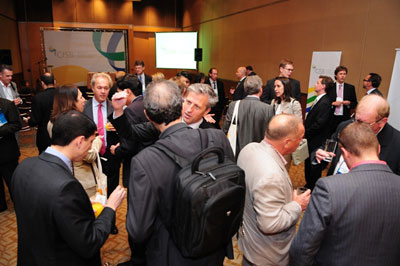 Carlos Costa, Specialist in International Projects for Brazilian Agency for Industrial Development (ABDI), believes that the creation of CISB adds value to an ongoing process. According to him, Sweden has been considered a strategic partner by the Brazilian government, but only in 2005 the contacts with the country were intensified. In 2009, ABDI created a specific project for technology and innovation collaboration for the country. Carlos Costa, Specialist in International Projects for Brazilian Agency for Industrial Development (ABDI), believes that the creation of CISB adds value to an ongoing process. According to him, Sweden has been considered a strategic partner by the Brazilian government, but only in 2005 the contacts with the country were intensified. In 2009, ABDI created a specific project for technology and innovation collaboration for the country.
For him, the entrance of CISB to this articulation boosts the results of the approximation. “The creation of CISB within the context in which Brazil gets close to Sweden is highly welcome, since it enhances the institutional level and helps maintain an ongoing relationship. Thus, CISB creates a real possibility of advancing this agenda and connecting important projects for both nations,” he states.
Currently, the organization has six institutions admitted as members, and there are 40 letters of intention signed by future partners. On the first phase, CISB has mainly congregated Sweden members, but the participation remains open to Brazilian interested parties and shall solidify over the coming months.
In addition to establishing specific discussions on how these partnerships will be made, the First Annual CISB Meeting was an opportunity for professionals related to the Center to come into contact with each other and exchange experiences. Even people from same-country organizations met for the first time or started a contact networking that will be positive for establishing partnerships. For Semida Silveira, professor of the Royal Institute of Technology (KTH), the meeting was important to increase the understanding about the role played by CISB and by each partner. “We are starting to execute ideas and, in this process, the role CISB plays becomes clearer. Now, how the projects will be applied must be defined,” she says.
Top » |

COOPERATION
Agreement based on complementariness
With different profiles, Brazil and Sweden find opportunities for working together
 When questioned about the reasons for establishing cooperative works, the CISB partners are unanimous in affirming the complementary nature between Brazil and Sweden. The Swedish experience in leading-edge technology, collaborative and innovative projects can partner in a promising manner with the booming Brazilian market. “We are highly interested in developing an economic relationship applying our expertise in innovation with Brazil’s broad industrial base,” exemplifies Magnus Robach, Sweden’s Ambassador to Brazil. When questioned about the reasons for establishing cooperative works, the CISB partners are unanimous in affirming the complementary nature between Brazil and Sweden. The Swedish experience in leading-edge technology, collaborative and innovative projects can partner in a promising manner with the booming Brazilian market. “We are highly interested in developing an economic relationship applying our expertise in innovation with Brazil’s broad industrial base,” exemplifies Magnus Robach, Sweden’s Ambassador to Brazil.
Both countries have government agencies that work for fostering innovation. In Brazil, this role is played by ABDI. The organization works via public industry development policies along with policies on science, technology, innovation and foreign trade. It is directly related to the application of the Brasil Maior [Greater Brazil] plan – third industrial policy program launched, now focused on innovation – that aims boosting the current growth of the Brazilian economy into a more solid and lasting scenario. “The purpose of Brasil Maior is to maintain the steep growth rate through insertion of innovation generation variables,” defines Carlos Costa, Specialist in International Projects from ABDI. “The major challenge is to maintain connections that are both independent and interdependent– that is, ones must develop autonomously (without governmental support), but maintain a level of cooperation,” he says.
One of the paths for Brazil to become increasingly robust is establishing international partnerships. For this reason, CISB maintains a close relationship with Vinnova, Swedish governmental agency for innovation systems. With vast experience in collaborative projects, Sweden can add great value to the Brazilian experience. According to Ciro Vasquez, International Collaboration Officer for Vinnova, the cooperation culture developed in the country attached to its peculiarities. “We are a small country in extension and population – it is not a big market. For this reason, we need to create relationships and become a reference in innovation to stand out and attract companies from all over the world,” he says.
One of the main examples of this experience is the Lindholmen Science Park, a science and technology park located in the city of Gothenburg (Sweden), where players from the triple helix of government-academia-industry coexist in broad integration. The park’s proposal is to not only promote proximity among its occupants, but also a physical coexistence, since different spaces are created for the joint development of ideas. The proposal of arenas that CISB adopts is inspired in this model, which understands the need for maintaining spaces for meeting and evolution of collaborative projects.
To become a strong economy, the Swedish bet on joint development with multinational companies and, thus, became the gateway for the European market. In spite of the progress, the country is still facing challenges, such as increasing the share of small and medium businesses in the investment in innovation, as well as optimizing the result of investments made in research for the economy. Brazil enters this scenario as a promising market for the Swedish economy, as well as an important commercial and technological partner.
For Marcos Vinícius de Souza, Director of Innovation for the Brazilian Ministry of Development, Industry and Foreign Trade, Brazil plays a double role in the global economy as a producer and consumer, which results in an attractive scenario for developing partnerships. “We are among the top ones in the commodities market, but we still need to strengthen the production chains to reach higher added value,” he states. “For this reason, we bet on Sweden, which has an extremely compatible culture of cooperation. We will attract not just facilities, but also knowledge,” he claims.
Top » |

ARENAS
Collective thought
Divided into groups by theme arenas, professionals discussed key issues related to the main challenges that can be worked through open innovation
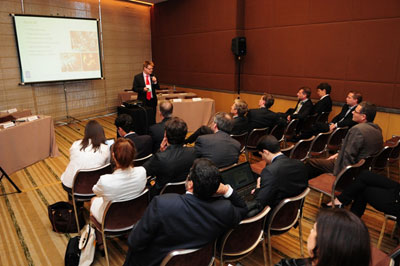 One of the guiding points of the First Annual CISB Meeting was the creation of the Security and Transport arenas. They were organized from the identification of major theme areas related to challenges and possibilities of work for both countries. The concept of arena is based on the proposition of common discussion environments for the triple helix members. In March 2012, the Energy arena shall also be launched by CISB. One of the guiding points of the First Annual CISB Meeting was the creation of the Security and Transport arenas. They were organized from the identification of major theme areas related to challenges and possibilities of work for both countries. The concept of arena is based on the proposition of common discussion environments for the triple helix members. In March 2012, the Energy arena shall also be launched by CISB.
At the Security Arena, the professionals looked for alternatives for collaboration projects related to security issues. The program has the goal of reinforcing the ability to handle crises and capacity of facing social problems. In addition to presenting the Swedish model of research and development in security, safety alternatives for urban services such as infrastructure, transportation and water supply, information and communication systems, and healthcare-related services were discussed.
 The Transport Arena addressed some of the main challenges faced by the Brazilian and related governments such as urban traffic, renewable fuels and long-distance transportation. Jurandir Fernandes, State Secretary of Metropolitan Transportation for the Sao Paulo government, highlights the relevance of this discussion. He believes that mobility is an urgent challenge in Brazil. “The Metropolitan Region of Sao Paulo is the third biggest urban stain in the world, only behind Tokyo and New Delhi. There are complex issues to be solved and, for this purpose, it is necessary to innovate. It is clear that we will not solve a growing problem like this one using more of the same. The public managers need courage to implement the unusual,” he states. The Transport Arena addressed some of the main challenges faced by the Brazilian and related governments such as urban traffic, renewable fuels and long-distance transportation. Jurandir Fernandes, State Secretary of Metropolitan Transportation for the Sao Paulo government, highlights the relevance of this discussion. He believes that mobility is an urgent challenge in Brazil. “The Metropolitan Region of Sao Paulo is the third biggest urban stain in the world, only behind Tokyo and New Delhi. There are complex issues to be solved and, for this purpose, it is necessary to innovate. It is clear that we will not solve a growing problem like this one using more of the same. The public managers need courage to implement the unusual,” he states.
For Per-Arne Eriksson, Director of Product Development and Quality of Scania, a promising trend for bilateral work is the research with biofuels. “Brazil is strong when it comes to alternative fuels, such as ethanol, which we are highly interested in studying as an option for buses and trucks. More than an issue of technology development, the application of this knowledge in the market also depends on factors such as fuel price stability,” he says.
A good example of collaborative project was presented by Niklas Berglin, Senior Project Manager for Innventia. Named Polynol, the initiative includes using the paper industry’s infrastructure to produce polymers and fuels from renewable sources. According to him, the key factor for the success of this type of project is the involvement of all partners throughout the industry’s value chain, for establishing a strong and cohesive group with collaboration from universities in Brazil and Sweden, as well as governmental institutions as financers.
Capability Development Centre
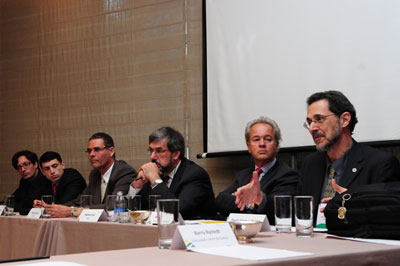 Another discussion group addressed the concept of Capability Development Centre (CDC), a tool that Saab and CISB plan to implement in Brazil. The Centre is a facility with adoption of real-time simulation systems that allow different competencies to group in order to discuss and organize the knowledge available for integrating complex systems, such as defense and safety systems, or for the organization of complex operations, such as the World Cup or the Olympic Games. The model has never been adopted in Brazil and is based on the Swedish and South African experiences. Another discussion group addressed the concept of Capability Development Centre (CDC), a tool that Saab and CISB plan to implement in Brazil. The Centre is a facility with adoption of real-time simulation systems that allow different competencies to group in order to discuss and organize the knowledge available for integrating complex systems, such as defense and safety systems, or for the organization of complex operations, such as the World Cup or the Olympic Games. The model has never been adopted in Brazil and is based on the Swedish and South African experiences.
During the meeting, Piet Verbeek, general retired from the South African National Defense Forces, introduced the CDC as an alternative to develop government solutions in the security segment. The system is used as a tool to demonstrate concepts and scenarios to government clients, establishing bases for integration, tests and assessments, as blocks being built according to the need. The architecture of the South African CDC is comprised of a laboratory environment and planning sessions. With the system, the country created a Project and Validation Center, used as a source of knowledge for developing solutions throughout product lifecycles and present operations (military, for example) to representatives from government organizations and the Army.
With the proximity of the World Cup and the Olympic Games in Brazil, the model is convenient for developing solutions based on multidisciplinary teams. According to Johannes Swart, Campaign Leader for Sisfron & Sisgaaz projects in Brazil, responsible for Saab’s CDC in South Africa, the CDC can be understood as a knowledge library in which people from different areas who meet for a single purpose are more important than the material accumulated. For him, the sooner one starts to work on this model, the more prepared the team is when it needs to work.
Swart highlights that, in South Africa, in addition to being used for demonstrations to FIFA and to other players involved, the CDC helped developing command and control systems for the 2010 World Cup, with the creation of the JOPS – Joint Operating Picture System. With the gradual development of the JOPS, in order to adjust to the countdown for the 2009 Confederations Cup and to the 2010 World Cup, drills were conducted displaying the difference between the usual time for understanding a crime situation and the need to notice this in real time. Swart states that the reaction needs to be immediate in such an event to prevent, for example, an aircraft that represents a potential hazard from entering the restricted airspace of a soccer stadium, when it is too late for an action that avoids collateral damages (taking the airplane down near a stadium may have tragic consequences for the public on the ground).
Fostering
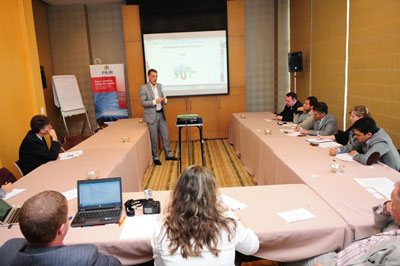 The meetings also addressed ways to get fundings. In addition to creating discussions on alternatives for joint project development, the Open Innovation Arena & International Collaboration gathered representatives from Brazilian fostering agencies and had four CISB members – Innventia, Saab, Scania and SP – exhibiting their main innovation ideas and projects. In addition to them, the chairs of the Security and Transport arenas presented challenges in those areas, which were discussed by representatives from Fapesp, CNPq, CAPES and the Brazilian Ministry of Foreign Relations. Also attending were representatives from the Inter-American Development Bank, ABDI and the Brazilian Ministry of Development, Industry and Foreign Trade, as well as Magnus Robach, Sweden’s Ambassador to Brazil. The meetings also addressed ways to get fundings. In addition to creating discussions on alternatives for joint project development, the Open Innovation Arena & International Collaboration gathered representatives from Brazilian fostering agencies and had four CISB members – Innventia, Saab, Scania and SP – exhibiting their main innovation ideas and projects. In addition to them, the chairs of the Security and Transport arenas presented challenges in those areas, which were discussed by representatives from Fapesp, CNPq, CAPES and the Brazilian Ministry of Foreign Relations. Also attending were representatives from the Inter-American Development Bank, ABDI and the Brazilian Ministry of Development, Industry and Foreign Trade, as well as Magnus Robach, Sweden’s Ambassador to Brazil.
In addition to representatives from fostering agencies hearing about the expectations from Swedish companies for technology development in Brazil, the arena gave opportunities for agencies to introduce themselves. They displayed their main fostering programs and discussed their role in the context of international collaboration, raising realistic options for collaboration in the Brazilian context. The highlights were the collaborative programs from Fapesp, addressed by Sergio Queiroz, Innovation Coordinator, and the program Science without Borders, by CAPES and CNPq.
For Bruno Rondani, Executive Director of CISB, it became clear that Brazil presents many opportunities for Swedish activities. “As in any country, each of these agencies has peculiarities for creating financing lines or making available resources for research and development. CISB is at a position of helping Brazilian and Swedish partners make feasible operation models that adjust the best to these profiles,” he explains.
Top » |

AGREEMENT
Exchange for development
CISB signs agreement with CNPq and Saab for creating scholarship grants in Sweden for Brazilian researchers
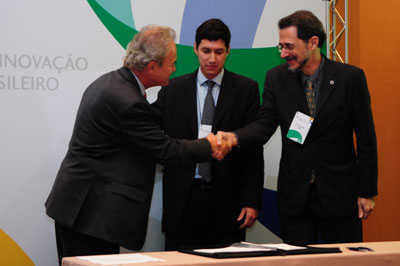 An important highlight of the First Annual CISB Meeting was the signature of the cooperation agreement between CISB and CNPq in the scope of the program named Science without Borders, from the Brazilian Government, which aims at promoting the student exchange. Both institutions, along with Saab, also signed an addendum that creates 100 scholarship grants for students and researchers in Sweden. Targeted at doctorate and PhD students, specialists and visiting professors, they will be co-financed by CNPq and SAAB. The peculiarity of this exchange is in the focuses on collaborative research and development between Brazil and Sweden, related to the possibilities for application in the market. An important highlight of the First Annual CISB Meeting was the signature of the cooperation agreement between CISB and CNPq in the scope of the program named Science without Borders, from the Brazilian Government, which aims at promoting the student exchange. Both institutions, along with Saab, also signed an addendum that creates 100 scholarship grants for students and researchers in Sweden. Targeted at doctorate and PhD students, specialists and visiting professors, they will be co-financed by CNPq and SAAB. The peculiarity of this exchange is in the focuses on collaborative research and development between Brazil and Sweden, related to the possibilities for application in the market.
Paulo Beirao, Director of Agricultural, Biological and Health Sciences for CNPq, believes that the document is representative. “This agreement illustrates what we want to achieve, because it displays common interests that led to such a fruitful agreement, which can and must be reproduced,” he says. A considerable gain for researchers, in addition to the academic relevance, is the expansion of network and knowledge of the Swedish context that may benefit the Brazilian industry.
The ceremony also featured the signature of five letters of intention from Swedish universities and members of CISB for future participation on the program. CISB has developed a strategic work in enabling exchange programs for Sweden in agreement with the work from the federal government. In total, the program Science without Borders forecast 75,000 scholarship grants. The goal is to target 1,000 from this total to Sweden throughout five years via articulation from CISB.
Top » |

OPEN INNOVATION SEMINAR
Swedish presence at the OIS
Swedish professionals stand out at the schedule of the Open Innovation Seminar 2011
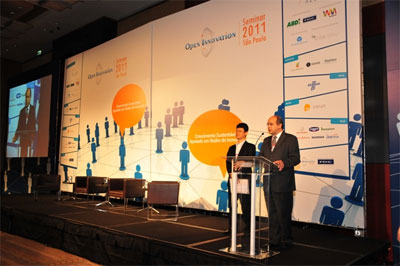 The First Annual CISB Meeting integrated the schedule of the Open Innovation Seminar (OIS), the biggest event in Latin America dedicated to innovation networks. In addition to the presence at the CISB Arena, Swedish professionals and organizations stood out with participation in lectures and debate panels at the OIS. The First Annual CISB Meeting integrated the schedule of the Open Innovation Seminar (OIS), the biggest event in Latin America dedicated to innovation networks. In addition to the presence at the CISB Arena, Swedish professionals and organizations stood out with participation in lectures and debate panels at the OIS.
Several Swedish organizations, such as Scania, SP and Innventia, took part on the debates, both as listeners and as lecturers. The model from the Lindholmen Science Park was a highlight through the presentation by its CEO, Niklas Wahlberg, displaying how it is possible to promote open innovation in its different phases via broad integration mode. Wahlberg also integrated the panel “Innovation for regional development”, from which Pontus de Laval, Chief Technology Officer for Saab, and Joakim Appelquist, Director of International Collaboration and Networks for Vinnova, also took part. Vinnova was the topic of a lecture in which its method of operation and experience in international collaboration were introduced to the Brazilian audience. According to Appelquist, international cooperation is a relationship that may not be simple, but is fully possible. For him, the important in this type of partnership is to deeply know the context of the country with which one has a relationship in order to pursue common goals and the best ways for both to gain with the exchange, adapting to different opportunities.
Additionally, Brazilian professor Semida Silveira called attention on the event both for the projects she leads and for the strategic position in the Brazil-Sweden relationship she plays, since she knows the reality of both countries. She is the head of the Division of Energy and Climate Studies of Sweden’s Royal Institute of Technology. Semida participated on the panel “Challenges in building innovative cities” and presented Stockholm’s experience in innovation projects for the urban challenges, using as an example the Hammarby Sjostad district, where water and power consumption are managed integrated to residue handling. The Swedish academia world was also represented by Niklas Berglin, Senior Project Manager of Innventia, who gave the lecture “Multinationals and global innovation in knowledge-intensive industries”.
Another highlight was the participation from Saab at the event with the presentation of Gripen, one of the most advanced fighter aircrafts in the world. With a flight simulator assembled in an area near the debate rooms, the company attracted nearly 1,200 people interested in its operation and innovation. According to Pontus de Laval, Gripen is an example of the successful application of the triple helix, and the company’s proposal is for the model’s new generation to be developed in partnership with Brazil via Brazilian Air Force’s F-X2 program, which includes the modernization of its equipment units via technology purchase and transfer.
Top » |
 |